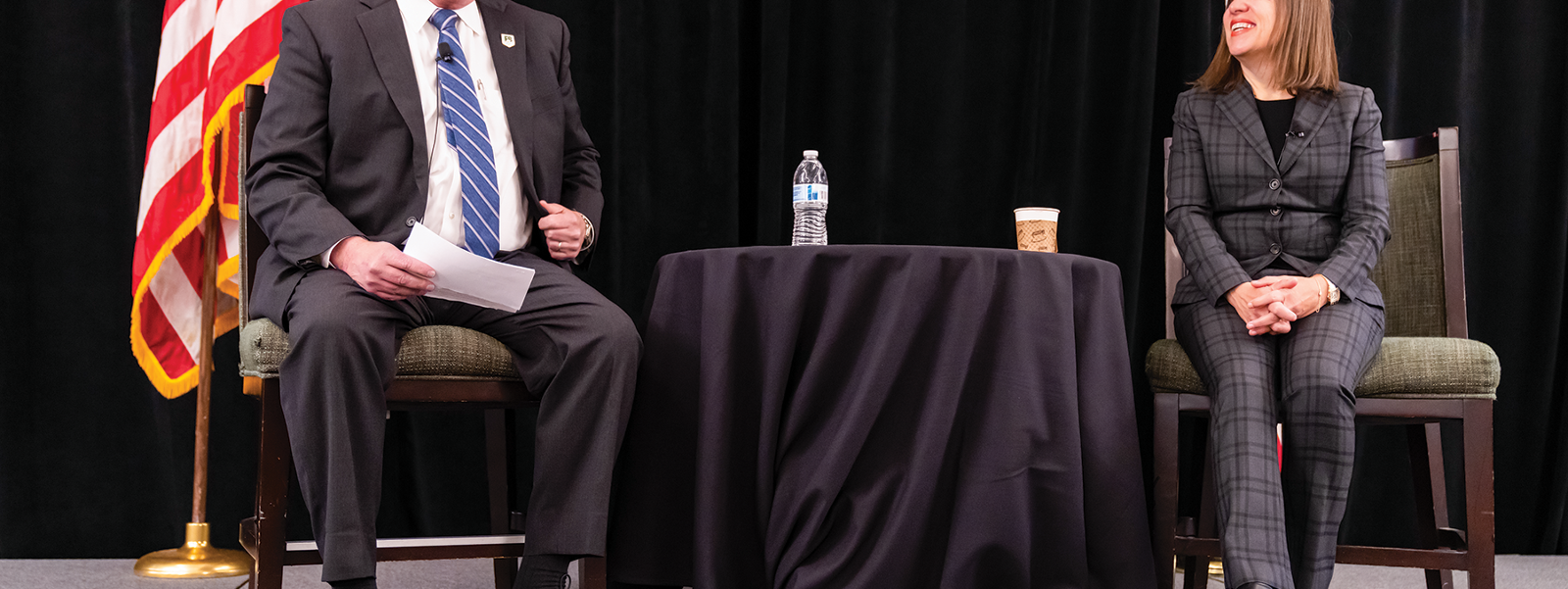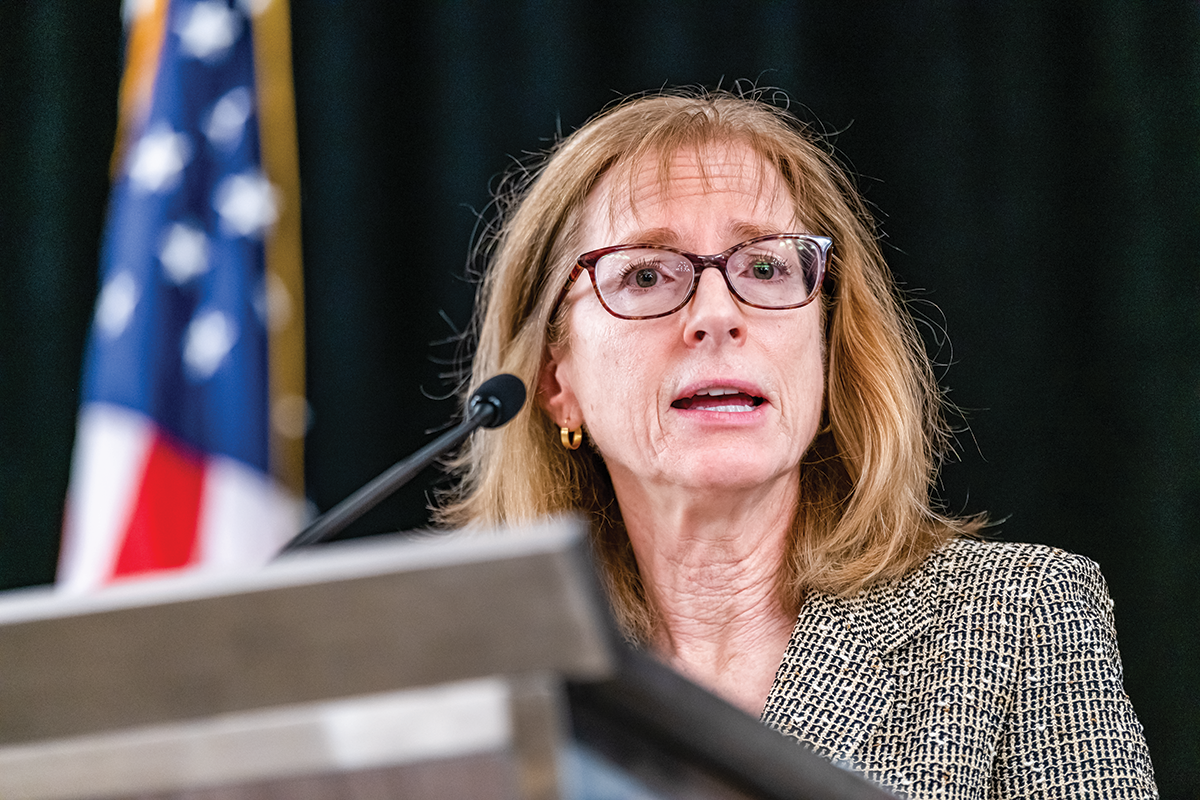Water, flood impacts inspire dialogue at Capitol Ag event

Photo/Brian Baer
California Farm Bureau President Jamie Johansson interviews Lt. Gov. Eleni Kounalakis, who described Farm Bureau as “an incredibly important voice for agriculture.”


Dorene D’Adamo, vice chair of the California State Water Resources Board, delivers a presentation on water supply, infrastructure and regulations.
By Christine Souza
As California farmers and ranchers work through challenges including floods and droughts, water cutbacks, crop damage, inflation and supply-chain disruptions, they look to engage with government leaders on solutions.
At the California Farm Bureau’s Capitol Ag Conference in Sacramento, members from across the state went to work on the organization’s legislative agenda—with Lt. Gov. Eleni Kounalakis, state lawmakers and agency officials present for direct conversations.
“There is a better way,” said Farm Bureau President Jamie Johansson, as he opened the event by championing grassroots advocacy by member farmers and ranchers. “We think it has a lot to do with our policy book, with the decisions that we make at our county levels and at our state levels.
“There is a better way, and lawmakers are going to be open to the concerns because they’re hearing it from their constituents. They’re hearing about the high prices, high energy costs and the lack of water,” he said. “It’s even apparent in the media: ‘Why are we in a drought with all this water running out to the ocean? Why can’t we keep some of this water?’”
Kounalakis, the keynote speaker, answered questions from Johansson and attendees on water, energy, the state budget, higher education and more.
A California native who grew up in rural Sacramento County, Kounalakis is the state representative for international affairs and trade, and previously served as U.S. Ambassador to Hungary. She told farmers about her father, a prominent real estate developer who immigrated to the U.S. from Greece as a teenager and worked briefly in agriculture. She praised the state’s farmers and ranchers for the work they do.
“When it comes to farming sustainably, when it comes to the best labor practices, I think it’s safe to say anywhere in the world, when it comes to the quality of the agriculture and the quantity of the agriculture, nothing compares to California,” Kounalakis said. “No place in the world farms the way that you farm.
“It should be very, very well known, certainly in Sacramento in the Legislature, of what it has taken and how proud Californians should be about our ag industry,” she added. “I will do my part to help make sure that the message and the word gets out.”
With flooding impacting many California communities, Johansson pointed to the need to capture water for future use. He added that many water infrastructure projects have been in the works for decades, such as building Sites Reservoir and Temperance Flat Dam and raising Shasta Dam. In 2014, state voters approved the $7.1 billion Proposition 1 water bond to fund such projects, which face burdensome regulatory reviews and delays. “Why can’t we do better as a state?” Johansson asked.
Kounalakis said the water projects must go through “very cumbersome processes.” She added, “Right now, with all this water, people are saying, ‘Well, the drought’s over, right? How could it not be over? Look at all this water.’ If it rains more and melts too fast, you’re not going to capture it.”
San Diego County egg farmer Frank Hilliker suggested that the state repair existing dams to bolster water supply.
“There are 53 dams in the county, with 10 of them considered high hazard, which means they cannot be filled,” Hilliker said. “We have about 140,000 acre-feet to 150,000 acre-feet of water we could be storing down in San Diego, and this is probably indicative throughout the state. Isn’t it a little bit easier to fix the dams we have, so we can fill them up?”
Kounalakis answered, “Those are the kinds of projects that I want to know about.”
As warm temperatures melt the snowpack and water is lost to aridification, Dorene D’Adamo, vice chair of the California State Water Resources Control Board, said the California Department of Water Resources expects the state’s surface water supplies to decrease 10%, or 6 million acre-feet, by 2040.
The Newsom administration is acting on a strategy to make up for the anticipated shortfall, D’Adamo said, by “really accelerating efforts through a number of different categories.” She said those efforts, including working to complete water projects under Proposition 1, can add an additional 2.7 million acre-feet of off-stream storage and groundwater storage. Other projects she touted include conveyance improvements, the delta tunnel, water recycling and groundwater recharge.
Johansson applauded executive orders by Gov. Gavin Newsom last month as positive steps for agriculture and water users. One order temporarily lifts permit restrictions so water users can divert floodwaters to farmland for groundwater recharge. Another suspends drought regulations, including curtailment orders put in place two years ago for certain watersheds. Johansson said, “The governor has taken some positive steps, so we will give credit where credit is due.”
D’Adamo noted that Newsom rescinded some drought curtailment orders issued by the state water board two years ago. In the watersheds where the curtailments have been lifted, she said, “That’s helpful for many that can breathe a sigh of relief.” But she said curtailments remain in “watersheds where we’re continuing to see significant fish flow issues, and that’s the Scott (River) and the Shasta (River).”
She said the state remains in a groundwater deficit and recognized that local agencies are working to achieve sustainability in aquifers as required by the 2014 Sustainable Groundwater Management Act. The state water board, she said, is reviewing rejected plans for six groundwater basins and will develop recommendations.
The water board also continues work on the Sacramento-San Joaquin River Bay-Delta Water Quality Control Plan, she said, adding that some water users have presented voluntary agreements that include a combination of unimpaired flows and habitat restoration.
In discussing actions by the California Legislature this year, Johansson told members he expects many new bills related to water, including for funding water infrastructure, streamlining permitting and addressing SGMA challenges. But other legislation seeks to dismantle the state’s water rights system, he added.
“Some want to do away with how we appropriate water in this state, a dangerous proposition for us and a dangerous proposition for Californians,” Johansson said. “Our success and our ability to come through a drought, as painful as it was and with the hurt we may have had, we kept order in the state because we knew where the water should go and who was in line to get the water.”
As Kounalakis discussed education, Imperial County farmer Ronnie Leimgruber endorsed making greater investments in technical education.
“We don’t have the technical expertise that we’re going to need with driverless tractors, electronic tractors, electronic thinning machines and harvesting machines,” Leimgruber said. “As a farmer, we can’t even work on these tractors anymore. We need to really encourage and prop up the trade schools because there is going to be a big shortage in the near future.”
Kounalakis agreed, suggesting that the Farm Bureau identify jobs that would benefit agriculture. She said efforts could involve connecting with community colleges and California State University about building programs to fit the need.
Johansson mentioned the state’s 2023-24 proposed budget, which is projected to have a shortfall after two years of budget surpluses. He recalled the 2019 budget included large cuts to agricultural education programs.
“A shortfall usually means a lot of cuts and also means a lot of cuts to programs that we depend on to comply with regulations,” he said.
The state budget shortfall is expected to exceed $30 billion. The actual figure should be known when a revision of the proposed budget is released in May.
(Christine Souza is an assistant editor of Ag Alert. She may be contacted at csouza@cfbf.com.)




